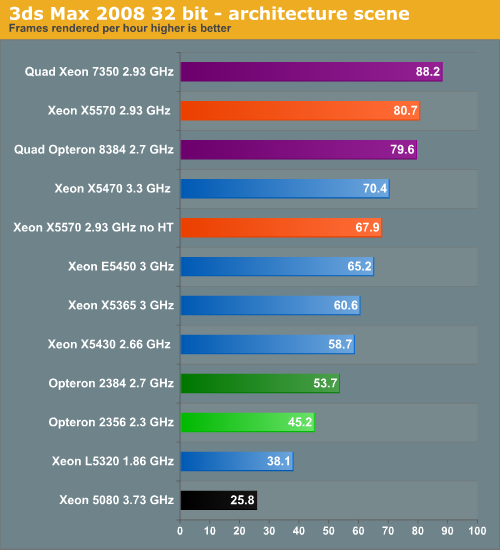The Best Server CPUs part 2: the Intel "Nehalem" Xeon X5570
by Johan De Gelas on March 30, 2009 3:00 PM EST- Posted in
- IT Computing
| Rendering: 3ds Max 2008 | |
| Operating System | Windows 2008 Enterprise RTM (64-bit) |
| Software | 3ds Max 2008 |
| Benchmark software | Build in timer |
| Typical error margin | 1-2% |
Render server are only a small part of the server market. We used the "architecture" scene included in the SPEC APC 3DS Max test. All tests were done with 3ds max's default scanline renderer, SSE enabled, and we rendered at HD 720p (1280x720) resolution. We measured the time it takes to render 10 frames (from 20 to 29) and then calculated (3600 seconds * 10 frames / time recorded) how many frames a certain CPU configuration could render in one hour. Results are reported as rendered images per hour.

We used the 32-bit version of 3ds Max 2008 on 64-bit Windows 2008 RTM. The 64-bit version of Windows 2008 is a bit slower (especially when you use the scanline renderer). All CPU configurations are dual, unless we indicate otherwise.

When it comes to floating point and SSE, the performance gains over several CPU generations are a bit smaller. The Xeon 5570 again shatters all records, but it's "only" three times faster than the Xeon 5080. There are two reasons for this. First, the Xeon 5080 is based on the Pentium 4 architecture. Thanks to its high clock speed, it can deliver relatively high FLOPS (Floating Point Operations per Second). The high branch prediction penalty, the relatively low hit rate of the trace cache, and very high memory latency which all made the Pentium 4 based Xeons very inefficient in integer code are of no real importance when running floating point intensive applications such as 3ds Max.
Improvements have been slower in this area. In the Xeon 51xx we have seen the introduction of 128-bit SSE units (AMD: Barcelona, Opteron 23xx) and faster 4-bit RADIX in the Harpertown Xeon (Xeon 54xx). We analyzed this in great detail previously: while the Opterons are still better at divisions, the Xeon 54xx is faster in multiplications which are much more common. The Xeon 55x "Nehalem" is almost identical to the Xeon 54xx "Harpertown", while the AMD "Shanghai" is identical to AMD "Barcelona" core when it comes to floating point. Notice how the Nehalem at 2.93GHz (in reality 3.1GHz) settles between the 3GHz and 3.3GHz Xeon 54xx. This confirms that floating point code hardly sees a difference between a Harpertown and a Nehalem… unless it is limited by the bandwidth available to the core of course. Nehalem can still beat its older brothers thanks to SMT, once again underlining what a powerful weapon SMT is.
While the Xeon X5570 is only 24% faster than the Xeon 5450, that is good enough to make the current 4-way servers completely useless for rendering. The dual Xeon "Nehalem" offers the same performance at much lower price points, while consuming a lot less power.










44 Comments
View All Comments
Veteran - Wednesday, April 1, 2009 - link
I didn't mean to offend you, because i can imagine how much time it takes to test hardware properly. And i personally think that OLTP/OLAP testing is very innovative and needed. Because otherwise people would have no idea what to buy for servers. You cannot let you server purchase be influenced with meaningless (for servers) simple benchmarks like 3D 2006/Vantage/FPS test etc.You guys always are doing a great a job at testing any piece of hardware, but it is just feeling to much biased towards Intel. For example, at the last page of this review you get a link to Intel resource Center (in the same place as the next button). If you have things like that, you are not (trying to be) objective IMO.
JohanAnandtech - Wednesday, April 1, 2009 - link
Thank you for clarifying in a very constructive way."the last page of this review you get a link to Intel resource Center"
I can't say I am happy with that link as it creates the wrong impression. But the deal is: editors don't involve in ad management, ad sales people don't get involved when it comes to content.
So all I can say is to judge our content, not our ads. And like I said, it didn't stop us from claiming that Shanghai was by far the best server CPU a few months ago. And that conclusion was not on many sites.
Veteran - Wednesday, April 1, 2009 - link
Thanks for clarrifying this matter.But ad sales people should know this creates the wrong impression. A review site (for me at least) is all about objectivity and credibility. When you place a link to Intel's Resource Center at the end of every review, it feels weird. People on forums already call Anandtech, Inteltech. And i don't think this is what you guys want.
I always liked Anandtech since when I was a kid, and I still do. You guys always have one of the most in-depth reviews (especially on the very technical side) and I like that. But you guys are gaining some very negative publicity on the net.
BaronMatrix - Tuesday, March 31, 2009 - link
Unfortunately, I don't buy from or recommend criminals.carniver - Wednesday, April 1, 2009 - link
AMDZone is the biggest joke on the internet. I just went there to see how the zealots like abinstein are still doing their damage control; just like before he went on rambling how the Penryn is still weak against Shanghai, and the old and tired excuses like how if people all bought AMD they can drop in upgrades etc etc. ZootyGray...he's the biggest joke on AMDZone. None of them had the mental capacity to accept AMD has been DEFEATED, which is disappointing but funny to say the leastduploxxx - Wednesday, April 1, 2009 - link
It's not just AMDZone, you are just the opposite. Its like in Woodcrest and conroe times, it's not because the high-end cpu is the best of all that the rest of the available cpu's in the line is by default better. It's all about price performance ratio. Like many who were buying the low-end and think they had bought the better system, well wrong bet.As mentioned before, why not test the mid range that is where the sales will be. Time to test 5520-5530 against 2380-82 after all those have the same price.
carniver - Wednesday, April 1, 2009 - link
Your argument is valid, however, it just so happens that for low end 1S systems the Penryns are doing just fine against the Shanghais, for higher end 2S systems they used to be limited by memory bandwidth and AMD pulls ahead. No more is this the case, Intel now beats AMD in their own territory.CHADBOGA - Tuesday, March 31, 2009 - link
You probably also can't afford to buy a computer, so I doubt that Intel will be too concerned with your AMDZone insanity. LOL!!!!smilingcrow - Tuesday, March 31, 2009 - link
Those grapes you are chewing on sure sound sour to me. Try listening to a few tracks by The Fun Loving Criminals to help take away the bad taste.cjcoats - Tuesday, March 31, 2009 - link
There's more to HPC applications than you indicate: environmental modeling apps, particularly, tend to be dominated by memory access patterns rather than by I/O or pure computation. Give me a ring if you'd like some help with that -- I'm local for you, in fact...